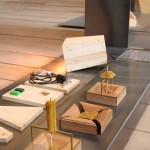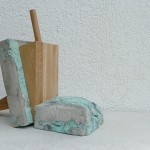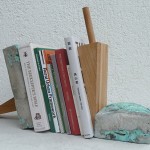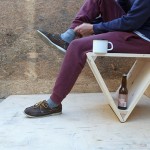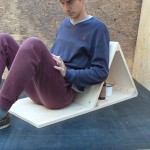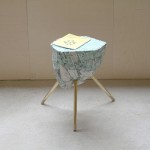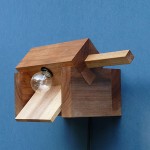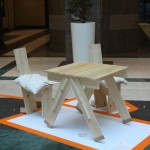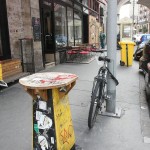smow blog Interview: Architecture Uncomfortable Workshop – We don’t believe form and function are closed, there is always a degree of personal freedom and personal interpretation.
As we’ve noted in the past, Hungarian architects and designers made a valuable contribution to the development of post war architecture and design.
Made.
For in recent years a Hungarian accent in the design discourse has been principally notable by its absence. By its stillness.
Which of course doesn’t mean there aren’t Hungarians producing intelligent, interesting, relevant and innovative work.
There are.
Hungarians such as the Budapest based practice Architecture Uncomfortable Workshop
Established in 2012 by a group of Budapest University of Technology and Economics students Architecture Uncomfortable Workshop, AUW are a multi-disciplinary practice who in addition to realising architecture projects also develop furniture, interior design and exhibition design projects and run the gallery fifth corner in Budapest.
We first became aware of Architecture Uncomfortable Workshop when we saw their candle holder as part of an exhibition of Hungarian design at Vienna Design Week 2014. In retrospect the very fact that we saw the candle holder can be understood as the hand of fate guiding us, gently, towards AUW. The showcase was unfavourably positioned, very awkward to view in any sort peace, yet there was no escaping the aesthetic delight and functional genuis of the AUW candle holder.
A week later at Budapest Design Week 2014 fate introduced us to further works by AUW including, the Board Chair, Leather Stool and Pieces for Books, a book end system which combines wood and concrete elements with the most charming brutality, intelligent functionality and which in its uncouth manner questions conventions on reduction and minimalism in furniture design. It’s fair to say that rarely have furniture designs excited quite as much as those of Architecture Uncomfortable Workshop.
To find out a little more about Architecture Uncomfortable Workshop we met up in Budapest with founding members Dénes Emil Ghyczy and Lukács Szederkényi to discuss the groups works, philosophies, Budapest as a creative city, but began by asking about the origins of Architecture Uncomfortable Workshop?
Lukács: It all really started as a carpentry workshop. My father has a friend who owned various buildings, including numerous workshops, which he decided to sell. My father suggested that maybe we could, should, buy the carpentry workshop, it wasn’t that expensive and so we bought the workshop complete with all the machines and this gave us a place of our own where we could work independently.
Dénes: At that time we had established an architecture practice, were starting to enter architecture competitions, building models, and were very aware that with architecture it is a long, slow process until you get real work and can start to realise your own ideas, and the carpentry workshop offered us a chance and the freedom to develop and realise our own projects.
smow blog: Those first projects have largely been furniture, on your website you say that for yourselves the furniture projects are about helping you understand architecture, in how far?
Dénes: You learn a lot about something from building it. With architecture you plan something but then generally give it to others to build; but if you have to build something, then the understanding of the process, materials and machines you get feeds back into your planning. And so now when we work on architecture projects we are thinking a lot more about how we can build it, and that is something we are really noticing with, for example, our current house project where such thinking has helped us to develop a detail or a form that we perhaps otherwise might not have thought about had we not considered the process.
Lukács: Architecture is largely about how you live, and also the smaller, furniture objects explain your personal relationship to your surroundings, so what is important for you and your needs.
smow blog: Or as you say on your website, it’s not about the form, not about the function, but about the situation?
Lukács: As an architect or designer you are always creating an environment around or for people. For me a piece of furniture works if it is strong enough to create its own space within a space, either compliment the larger space or work against it, but if it changes something about the space then for me it is working.
Dénes: Furniture doesn’t have to fit a space in an architectural sense that everything has to have the same form, be of the same material, that everything in a space has to somehow be harmonious, such realities only exist in architects’ minds. For us it is more important that every object in a space has its own identity and communicates with the space.
Lukács: The American sculptor Richard Nonas often talks about making strong objects which change the space, for all when you move through a space you should be aware that the space is changing as you move through it, and in certain respects we try to create something similar with our work.
smow blog: We’ve certainly always felt your furniture communicating with us, normally in a very harsh, raw, language, is this, lets say, unrefinedness of your furniture something you deliberately aim for, or is it more a natural consequence of your approach to design?
Dénes: I really don’t like artificially clean and sanitised objects where everything is nicely polished or coated with plastic so that everything appears perfect, although you know that under the coating it probably isn’t. With our furniture it is often the case that it takes a little time before you can fully understand it. You are clear what it is but it never tells you exactly what to do, it allows you a little freedom to explore. We don’t believe form and function are closed, there is always a degree of personal freedom and personal interpretation. If you wanted you could theoretically use all our furniture as fire wood!
Lukács: I think in addition it is also the case that as a designer you are never finished with an object, but rather you stop at a given position in an eternal development process and we certainly never think that an object as being completed.
Dénes: For example I made a simple little table to cover an electricity box in front of the cafe where we are currently sitting, and it has found a life of its own, has become a natural part of the street furniture and I feel as an object it is much better now that it was when I made it because it is working, it has found its function.
Lukács: In a sense it is also about trying to change concepts about what is “nice” and what is “not nice”. To get peoples’ attention today you have to try ever harder and designers make things ever more technical, or fancier or shinier and we just want to slightly lower the level of what is understood as “nice”. Our furniture is just a bit of wood, yet you can use it, can enjoy it, can understand it, grow and develop with it, develop a relationship with it, and that all without this bling-bling. In a way it’s like promoting books as an alternative to movies.
smow blog: You began with a carpentry workshop and your projects until now have been largely wood based, is that likely to remain the case or…?
Dénes: The question of materials is important for us. When we talk to people they often say, “Ah! You’re the carpenters!” But we don’t see it like that, we don’t see ourselves as exclusively wood workers, wood was the first material we understood, that we properly learnt how to work with, largely because we have the carpentry workshop, but that was one step in our development and we’ve always worked with other materials, if not so visibly.
smow blog: And the house you are currently working on, is that then concrete, brick.. ?
Dénes: No it’s wood! On the one hand that is related to the budget, and on the other for the sort of project it is wood is simply the most appropriate material.
smow blog: Changing tact slightly, for the likes of yourselves who are your Hungarian references, or as architects and designers do you have to look outwith Hungary for reference points?
Lukas: You have to look outwith Hungary. It’s a little like pop music, you’re not going to be influenced by Hungarian pop music, and so we tend to look more outwith Hungary than within. What does however interest me is Hungarian folk architecture, not so much the structures and the forms, I’m not so keen on this romanticism, but rather the combination of structure and materials is fascinating. I don’t believe in copying or simply recreating old forms, but I find the way they approached construction very interesting.
Dénes: Which sadly isn’t something you are taught as as student. The majority of the teaching at the university was concerned with foreign architecture, there were also courses on the history of Hungarian architecture, but they were always concerned with preserving historic buildings and not on, for example, using the lessons learned from previous generations to help your contemporary planning or approach to building.
smow blog: Briefly to end, is Budapest a creative city, is it a good city to be based in?
Dénes: Budapest has lots of hidden opportunities and while I don’t think it is a bad city to work in, it could be better. If we were doing the same thing in Vienna or Berlin I think we would have much more work and more success. Budapest isn’t the most inspirational environment. But we really enjoy working against this passiveness in Budapest, we enjoy the suffering; it’s a masochistic thing, and that makes us work harder than we would do for just for money, fame or success! But in all seriousness I think things are changing, more people here are understanding design and so despite the many problems you can currently do interesting things in Budapest.
Lukács: In many ways Budapest really wants to be like Berlin, but every city needs to find its own identity, an identity with which it is comfortable. And when Budapest finds that things will be much easier. Sometimes I feel in Hungary we try to hard to copy others, and for me it is important that we find our own way, and the fact that people discover and like our work is the most important thing for us.
More information on Architecture Uncomfortable Workshop can be found at http://auworkshop.com/
- Candle Holder by AU Workshop, as seen at Pure Hungarian, Vienna Design Week 2014
- Pieces for Books by Architecture Uncomfortable Workshop (Photo: AUW)
- Pieces for Books by Architecture Uncomfortable Workshop (Photo: AUW)
- Wall Chair by Lukács Szederkényi & József Szederkényi (Architecture Uncomfortable Workshop) (Photo: AUW)
- And wall chair as a floor chair……. (Photo: AUW)
- Concrete-Cu table by Lukács Szederkényi & Dénes Emil Ghyczy (Architecture Uncomfortable Workshop) (Photo: AUW)
- Switch Wall Lamp by Lukács Szederkényi & Dénes Emil Ghyczy (Architecture Uncomfortable Workshop) (Photo: AUW)
- Board chair & table by AU Workshop, as seen during Budapest Design Week 2014
- A small table in front of Cafe Központ, Budapest by Architecture Uncomfortable Workshop
Tagged with: Architecture Uncomfortable Workshop, AU Workshop, Budapest, Candle Holder
